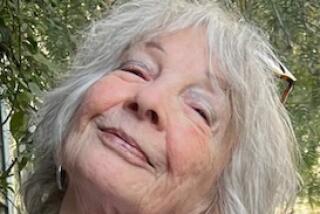MARILYN ‘UNABRIDGED’--AND STILL ELUSIVE
- Share via
Norma Jean Mortenson Baker Dougherty, who became Marilyn Monroe, would have been 61 on Monday, June 1. On Aug. 5, she will have been dead 25 years. That long; a small wince is allowed.
For those who are now in their 40s and beyond, Marilyn’s death was one of those news events about which you can remember how you heard it, where you heard it and how you felt. My family and I were on an ocean liner, moving to live and work in England, and the news, terse and undetailed, was the lead item on the single sheet of wireless reports slipped under the cabin door each morning. I’d never met her, but I felt a sense of personal loss.
Other reigning screen beauties have departed before their time: Jean Harlow at 26 from uremic poisoning, Carole Lombard at 33 in a plane crash, Carole Landis at 29 and Lupe Velez at 36, both by their own hands, Jayne Mansfield at 35 in a ghastly automobile accident.
But in life as in death, Marilyn more than any of the others has been the object of obsessive interest, having relatively little to do with the roles she played or even the publicity campaigns that Fox, her principal studio, conducted on her behalf.
Remembering Marilyn continues to be a substantial industry. One bibliography lists 53 books about her, commencing with two, both called “The Marilyn Monroe Story,” in 1953. The 54th, just being published, is the fan book to end all fan books, and I can’t imagine its having been assembled on behalf of any other movie personality.
It is “The Unabridged Marilyn: Her Life from A to Z” by Randall Riese and Neal Hitchens (Congdon & Weed, $25, 592 pp.). It is a Monroe almanac, with what reads like every knowable or alleged fact about her (10,000 of them, the publisher says), grouped in 1,500 alphabetical categories.
The reach is sometimes very long; Diana Dors gets a quick paragraph because she was known as Britain’s answer to Marilyn.
There are lists of her doctors (10), gynecologists (5) and psychiatrists (4). There is an accounting of the eight partial vials of drugs found in her house after her death, and an itemizing of the percentages of drugs (barbiturates, chloral hydrate, phenobarbital) identified in her system by the autopsy.
On the page facing the drug count is an entry for David Dunn, whose position in the Marilyn almanac is that he was the deputy county clerk who typed the marriage certificate for Marilyn and Joe DiMaggio in 1954. Ebbets Field gets an entry because Marilyn once kicked the first ball in a charity soccer game there in the ‘50s.
The authors list 30 of Marilyn’s alleged lovers, 29 men and a woman, and 54 places she lived, including a few listed simply as “unknown street,” with the dates, an implicitly gloomy commentary on the dreadful early years when she was careening among relatives and foster homes while her depressed and suicidal mother was in mental hospitals.
There are lists of the clothes she wore, the hotels she stayed at (with addresses), the illnesses she had, snippets from the reviews she received. The authors even include a quiz, threaded throughout the pages. (Where did Marilyn dine on her last night? La Scala restaurant.)
The book is said to reflect two years of research by the authors, neither of whom is old enough to have known Monroe in her lifetime. It began as a 200-page handbook and grew, and it is bizarre, mawkish, ghoulish, at once luridly fascinating and off-putting, a life reduced to a series of peep-show flashes which, like any autopsy, leave very little sense of what the animate being must have been like.
It may be that “The Unabridged Marilyn” will be seen by her fans as a relief from all the deep-dish analyses of her life, appeal and death, the most recent by Gloria Steinem. Certainly her life, before and during the Hollywood years, and the personality it produced--erratic and provocative, ambitious and easily bruised--was more interesting and endearing than any of the roles she performed.
The sadness is that the quantity of fame was so much larger than the quantity of work she did. It is hard not to be haunted by what she might have achieved in the years beyond 36. The sadness of the book is that for all the devotion that went into it, it only confirms the love goddess as a commercial commodity, subject to ongoing capitalization.
What were her last words on the screen? the authors ask. “How do you find your way back in the dark?” from “The Misfits,” in 1961.
More to Read
Sign up for our Book Club newsletter
Get the latest news, events and more from the Los Angeles Times Book Club, and help us get L.A. reading and talking.
You may occasionally receive promotional content from the Los Angeles Times.









